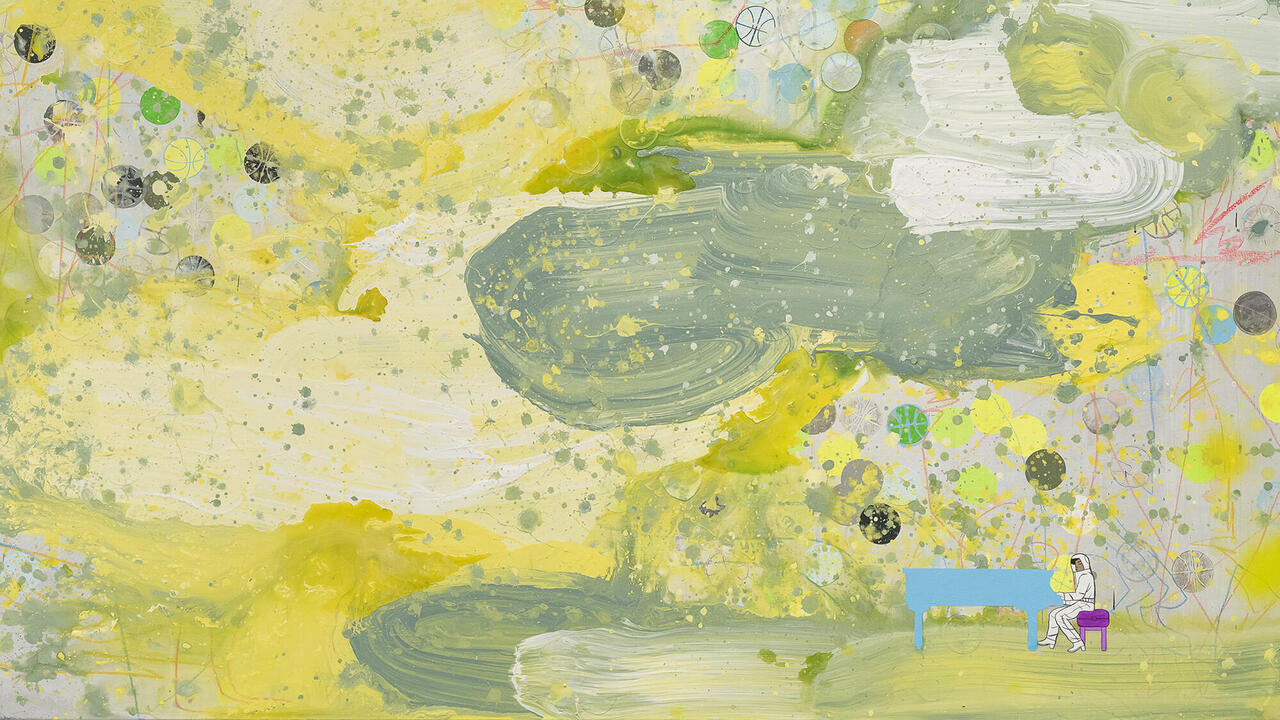Jack Lavender, Oliver Osborne, Marco Palmieri

A welcome mat lay at the centre of The Approach’s summer show of works by three young Londoners. In Jack Lavender’s Welcome (all works 2012), the salutation is printed on material similar to a mouse pad, the muddy gold lettering overlaid on an image of craggy rock and tiled as a four-by-four grid. This cold and forbidding design is quite incompatible with its message. Any resulting discomfort was coyly accented by a plastic mummy’s hand resting – fist upright – on its surface. Pattern-printed glass tumblers were also placed there, the kind of novelty kitchenware familiar from the early 1990s, yellow ivy running across some and the Pepsi logo printed on another. Above, a rectangular glass pane dangled from a rope, with short metal prongs somehow welded at the bottom, perforating a cast-metal doughnut. This arrangement was as curiously compelling as an awkward social gathering, all junk food and crass joviality.
Lavender had two wall-mounted hangings here too, where the rusty armatures were welded into large frames, each functioning like a web or net for the kind of cheap decorations you might find in a pound shop. In Gold Balloon , for instance, the eponymous object is cast so that it seems to float upwards from the frame. A shoelace hangs down from the top of the same armature and a clean glass plate is lodged at the bottom; a deflated ball, with a face printed on it, flops from the right. A century after Cubism ruptured pictorial space within painting, this work acknowledges that two-dimensional representation is a perforated sphere but continues on all the same. Gold Balloon is funny in a sad, self-effacing way, but the ensemble is again oddly transfixing.Oliver Osborne’s Rubber Plant (Empty Fridge) hung on an adjoining wall. Its subject is painted in detail in oil on linen, delicately lit as if by the moon against a midnight blue background; the rubbery-ness seems tangible in the density of the leaf, against which the light shines evocatively. Osborne has paid painterly attention to this, which makes the addition of a small digital print – cut and pasted at the centre of the composition – so surprising. Why spoil your captivating trompe l’oeil effect, Osborne, with this hasty intervention? The offending print shows two bewildered men staring into an empty fridge. It’s sketched in a loose, cartoon style but there are no accompanying captions. Everyone’s perplexed. A clue hung opposite, in another painting by Osborne. A similar print is pasted at the central point at which its six composite panels converge. It shows a rug with a bump in the centre and a tail hanging out, like some brattish cat, but there’s a caption this time (also the work’s title), ‘Jetzt ist Otto unter dem Teppich’ (Now Otto is under the rug), revealing the drawing to be an illustration from some anonymous grammar textbook and presumably the same source as Osborne’s previous print. Beneath, the six panels are covered in a mottled painting effect of a sky colour that might line a rococo ceiling or appear in a Romantic painting. John Constable once called his clouds ‘the chief organ of sentiment’ and so it seems that Osborne’s combinations are a ploy: pitch one didactic pictorial device against another and see what rebounds. As cloud effect or rubbery leaf are combined with fairly humourless educational illustrations, they demand fresh attention. What do we see when we’re not looking, Jetzt ist Otto unter dem Teppich might ask – a question that gives these paintings critical purchase.
The two oil on canvas works in Marco Palmieri’s diptych, Twins, comprise identical sketchy outlines of an upturned Roman head printed on two different backgrounds. One is on watery grey, the other on a horizontal yellow dissolving into blue like a nod towards the hues of Mark Rothko. Their sombre background fuzz is familiar from works by this iconic artist, but also oddly from the basic blurring effects of digital imaging. The icon of a Roman head is over-familiar too, so that its outline seeps in subtly rather than appearing in bold. One assumes Palmieri is attempting to combine his sources in a new kind of painterly abstraction, treating the familiar fog of pictorial colour fades and infinitely reproducible forms with the fluid qualities of paint. The exhibition was untitled, filed instead after the three artists’ names. And while it was a valuable and enjoyable display for all parties, the works slightly suffered from such close proximity to one another. They might all be considered as pictorial assemblages coming after Modernist painting when appropriation strategies abound. However, these categories are loose and rife and provide an insufficient framework for works of particular and sometimes exceptional sensibility.
















